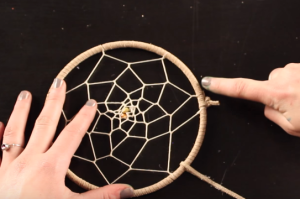DIY Dreamcatcher Guide: Your Dream Come True!
Table of Contents
The human psyche is an amazing thing, isn’t it? We go through so much during our wakeful moments, and many times these events, thoughts, and incidents can only be processed and internalized later on. This is precisely what sleeping and dreaming is all about. For the body, sleep is about rest, growth, and regeneration. For the mind, it is about taking everything in, and cataloging it all: short-term memory, long-term memory, physical memory, emotional memory, this goes here, that goes there… The brain takes it all in, puts the body to sleep, and begins the long and continual process of maintenance and repair.
Dreams play a big role in this. Sleep-induced dreams are the result of many things: from the food that we ate right before bed or the show we watched on TV, to the most significant events of the day, week, month, etc. Dreams can act as guides or hindrances, as friends or foes. Dreams have patterns which can be read, codes which can be deciphered, and so many layers…
Before anything, though, I think we can agree that what we are all looking for is a good night’s sleep. One which is not plagued by nightmares and negative energies. One of the ways to achieve this is by using a dreamcatcher.
What Is A Dreamcatcher?
 Originating in Native American practices (where it was nicknamed ‘spider’), a dreamcatcher is basically a small wooden hoop with a net or web over it (or woven inside it). Many times, the hoops are adorned with beads, feathers, or other items. It resembles a spider’s web.
Originating in Native American practices (where it was nicknamed ‘spider’), a dreamcatcher is basically a small wooden hoop with a net or web over it (or woven inside it). Many times, the hoops are adorned with beads, feathers, or other items. It resembles a spider’s web.
In Native American cultures, dreamcatchers were hung over cribs and children’s beds, as a means to protect them from negative energies. The bad vibes and dreams were said to get caught in the dreamcatcher web, and not be permitted to cause any harm to the child sleeping beneath it.
Decorate your home with an easy-to-make dream catcher. All you need is feathers, strings and some twigs.#DIY #DreamCatcher pic.twitter.com/5ZJ4MHRwzu
— ShiftKarado (@ShiftKarado) March 3, 2017
Do Dreamcatchers Really Work?
 Like any charm or talisman, it is not about the device, but more about the person who is wearing or carrying it. If you have faith in your ability to bring more positive energies to you and your bed, you may not need a dreamcatcher at all. This is perhaps why it was traditionally hung over the beds of infants and children – they lack the spiritual maturity to repel negative energy and cleanse themselves before bed.
Like any charm or talisman, it is not about the device, but more about the person who is wearing or carrying it. If you have faith in your ability to bring more positive energies to you and your bed, you may not need a dreamcatcher at all. This is perhaps why it was traditionally hung over the beds of infants and children – they lack the spiritual maturity to repel negative energy and cleanse themselves before bed.
For the native people of America, the dreamcatcher originated with a tribal legend, a certain belief in a guiding and helpful spirit. Nowadays, dreamcatchers are way too popular, and some Native Americans are not too pleased with the way that the dreamcatcher is being commercialized and misused.
So, do dreamcatchers work? They will if you want them to. The law of attraction suggests that what we project, we get back. If you believe in the ability of the dreamcatcher to protect you, it may just do that. However, remember that the original and most effective dreamcatcher is you.
How To Make A DIY Dreamcatcher
 Buying a dreamcatcher kind of devalues the whole thing, in my opinion. If you are interested in a device to help you sleep better, be calmer, and have better dreams – who better to prepare it for you than you?
Buying a dreamcatcher kind of devalues the whole thing, in my opinion. If you are interested in a device to help you sleep better, be calmer, and have better dreams – who better to prepare it for you than you?
Do some research into what kind of items or objects you would want to attach to the dreamcatcher, if at all. Do you want its hoop to be made of wood, or vegetation, or some other kind of material? And the net/web – do you want it to be made of string, of fabric, of hardened spaghetti? Do you want to adorn it with positively-charged feathers, stones, gems, or beads? A dreamcatcher should be a personal item, which is why I am all for making it yourself. The more of yourself you put into it, the better it can protect your unconscious mind and sleeping body.
The supplies themselves can be obtained from any art shop, I suppose. If you have another way to get these objects – one which you find more appealing – go for it. But I feel that ultimately it is the mental effort, and the spiritual and physical energy which is used in constructing it, which makes the most difference in the long run, and make your dreamcatcher that much more efficient.
I started out with a store bought one, many years ago, but when I learned a bit more about them, I constructed one for myself. I subsequently made ones for the kids, as they came along. When they were older, we made their own dreamcatchers, together, and replaced the ones I had made.
My Dreamcatcher Before and After Results
 Well, my story is a bit of a different one. Not a classic before and after tale, really. I started using a dreamcatcher (the original one, as I said, was store-bought) and keeping a dream journal at the same time. I also started to experiment with lucid dreaming techniques then, so the positive results I had cannot be all attributed to one single change. I didn’t get a dreamcatcher as the result of any bad vibes or nightmares.
Well, my story is a bit of a different one. Not a classic before and after tale, really. I started using a dreamcatcher (the original one, as I said, was store-bought) and keeping a dream journal at the same time. I also started to experiment with lucid dreaming techniques then, so the positive results I had cannot be all attributed to one single change. I didn’t get a dreamcatcher as the result of any bad vibes or nightmares.
My original dreamcatcher was there at a time when I making a very serious effort to learn as much as I could about myself, my dreams, and what they meant to show me. Concurrently, my dreams began to grow more and more clear, and more ambitious in nature. After a while, I started to notice my own patterns and codes, my own desires, wants, and needs. It was a fascinating time for me, to say the least.
Conclusion
I don’t keep my journal anymore, and at this point in my life my mind is too all-over-the-place to properly practice lucid dreaming. I hope to get back to doing both some day. But, we still have dreamcatchers around the house, above our beds. Do they work? It all depends on you. Do you believe in physical items connecting with the spiritual world? Do you believe in investing part of yourself, your sweat and blood, into bridging the gaps between what you know and what is yet unknown?
A dreamcatcher can be a cheaply constructed, made-in-China, 99-cents impulse buy at the cash register of a gas station, or it can be a serious stepping stone on the road to dreams and realities filled with greater purpose and self-awareness. It can be very meaningful, or completely meaningless. The choice is yours.
No comments yet.